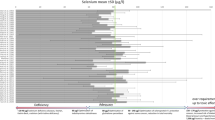Abstract
The levels and its interindividual and intraindividual variations of selenium (Se) and mercury (Hg) in erythrocytes and plasma were investigated in seven healthy young men during a period of 10 wk, with emphasis on the relationship to the dietary intake of several defined food items. The intraindividual variation, estimated by coefficients of variation (CVs), was 9.9% for plasma Se (PSe), 9.5% for erythrocyte Se (ESe), 42.4% for PHg, and 11.7% for EHg on the average. Significant correlations were found for mean ESe levels in each subject and his fish-eating frequency during this study (r=0.752, p<0.01). Weekly PHg levels were also correlated with average fish-eating frequency in the corresponding week of blood collection (r=0.367, p<0.05). Fish intake within 24 h before blood collection influenced PHg levels significantly.
Similar content being viewed by others
References
S. K. Gallagher, L. K. Johnson, and D. B. Milne, Short-term and long-term variability of indices related to nutritional status. I: Ca, Cu, Fe, Mg and Zn, Clin. Chem. 35, 369–373 (1989).
N. M. Solomons, O. Pineda, and D. B. Milne, Short-term intraindividual variability in plasma trace mineral concentrations, J. Micro-nutr. Anal. 2, 55–65 (1986).
A. C. Van Steirteghem, E. A. Robertson, and D. S. Young, Variance components of serum constituents in healthy individuals, Clin. Chem. 24, 212–222 (1978).
J. F. Pickup, E. K. Harris, M. Kearns, and S. S. Brown, Intra-individual variation of some serum constituents and its relevance to population-based reference ranges, Clin. Chem. 23, 842–850 (1977).
P. Winkel, B. E. Statland and H. Bokelund, The effect of time of venipuncture on variation of serum constituents, Am. J. Clin. Pathol. 64, 433–447 (1975).
E. Cotlove, E. K. Harris, and G. Z. Williams, Biological and analytic components of variation in long-term studies of serum constituents in normal subjects. III. Physiological and medical implications, Clin. Chem. 16, 1028–1032 (1970).
J. Sherlock, J. Hislop, D. Newton, G. Topping, and K. Whittle, Elevation of mercury in human blood from controlled chronic ingestion of methylmercury in fish, Hum. Toxicol. 3, 117–131 (1984).
T. Suzuki, S. Himeno, T. Hongo, C. Watanabe, and H. Satoh, Mercury-selenium interaction in workers exposed to elemental mercury vapor, J. Appl. Toxicol. 6, 149–153 (1986).
IPCS, Methylmercury, Environmental Health Criteria 101, WHO, Geneva (1990).
T. Suzuki, T. Hongo, T. Ohba, K. Kobayashi, H. Imai, H. Ishida, et al., The relation of dietary selenium to erythrocyte and plasma selenium concentrations in Japanese college women, Nutr. Res. 9, 839–848 (1989).
H. Imai, T. Suzuki, H. Kashiwazaki, T. Takemoto, K. Moji, and T. Izumi, Dietary habit and selenium concentrations in erythrocyte and serum in a group of middle-aged elderly Japanese, Nutr. Res. 10, 1205–1214 (1990).
T. Hongo, C. Watanabe, S. Himeno, and T. Suzuki, Relationship between erythrocyte mercury and selenium in erythrocyte, plasma and urine, Nutr. Res. 5, 1285–1289 (1985).
J. H. Watkinson, Fluorometric determination of selenium in biological material with 2,3-diaminonaphthalene, Anal. Chem. 38, 92–97 (1966).
L. Magos, Selective atomic-absorption determination of inorganic mercury and methylmercury in undigested biological samples, Analyst 96, 847–853 (1971).
R. Yamamoto, H. Satoh, T. Suzuki, A. Naganuma, and N. Imura, The applicable condition of Magos’ method for mercury measurement under coexistence of selenium, Anal. Biochem. 101, 254–259 (1980).
S. Shishido and T. Suzuki, Estimation of daily intake inorganic or organic mercury via diet, Tohoku J. Exp. Med. 114, 369–377 (1974).
B. G. Svensson, A. Schutz, A. Nilsson, I. Akesson, and S. Skerfving, Fish as a source of exposure to mercury and selenium, Sci. Total Environ. 126, 61–74 (1992).
G. Rice, J. Swartout, K. Mahaffey, and R. Schoeny, Derivation of U.S. EPA’s oral Reference Dose (RfD) for methylmercury, Drug Chem. Toxicol. 23(1), 41–54 (2000).
J. Gailer, G. N. George, I. J. Pickering, S. Madden, R. C. Prince, E. Y. Yu, et al., Structural basis of the antagonism between inorganic mercury and selenium in mammals, Chem. Res. Toxicol. 13(11), 1135–1142 (2000).
R. Cornelis, B. Heinzow, R. F. Herber, J. M. Christensen, O. M. Poulsen, E. Sabbioni, et al., Sample collection guidelines for trace elements in blood and urine. IUPAC Commission of Toxicology, Trace Elements Med. Biol. 10(2), 103–127 (1996).
M. P. Rayman, Dietary selenium: time to act, Br. Med. J. 314, 387–388 (1997).
A. MacPherson, M. N. I. Barclay, R. Scott, and R. W. S. Yates, Loss of Canadian wheat imports lowers selenium intake and status of the Scottish population, in P. W. F. Fischer, M. R. L’Abbe, K. A. Cockell, and R. S. Gibson, eds., Trace Elements in Man and Animals, N.R.C. Research Press, Ottawa, pp. 203–205 (1977).
M. Janghorbani, M. J. Christensen, A. Nahapetian, and V. R. Young, Selenium metabolism in healthy adults: quantitative aspects using the stable isotope SeO. Am. J. Clin. Nutr. 35, 647–654 (1982).
J. Neve, F. Vertongen, and L. Molle, Selenium deficiency, Clin. Endocrinol. Metab. 14, 629–656 (1985).
N. W. Griffiths, R. D. H. Stewart, and M. F. Robinson, The metabolism of Se selenomethionine in four women, Br. J Nutr. 35, 373–382 (1976).
J. Neve, F. Vertongen, and P. Caple, Selenium supplementation in healthy Belgian adults: response in platelet glutathione peroxidase activity and other blood indices, Am. J Clin. Nutr. 48, 139–143 (1988).
T. Suzuki, H. Imai, K. Kobayashi, T. Hongo, H. Kashiwazaki, R. Ohstuka, et al., Dietary intake of selenium in Japanese—an estimation analyzed and reported values in foodstuffs and cooked dishes, J. Jpn. Soc. Nutr. Food Sci. 41, 91–102 (1988) (in Japanese).
K. Yasumoto, K. Iwami, M. Yoshida, and H. Mitsuda, Selenium content of foods and its average daily intake in Japan, J. Jpn. Soc. Nutr. Food Sci. 29, 511–515 (1976) (in Japanese).
Author information
Authors and Affiliations
Rights and permissions
About this article
Cite this article
Karita, K., Suzuki, T. Fish eating and variations in selenium and mercury levels in plasma and erythrocytes in free-living healthy Japanese men. Biol Trace Elem Res 90, 71–81 (2002). https://doi.org/10.1385/BTER:90:1-3:71
Received:
Accepted:
Issue Date:
DOI: https://doi.org/10.1385/BTER:90:1-3:71




